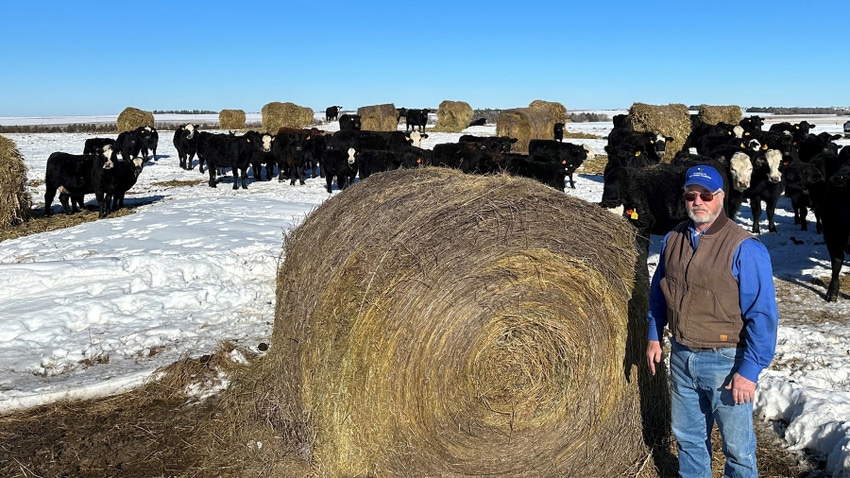March 6, 2024

“Try it! You’ll like it.” That was a popular advertising slogan for an antacid decades ago. Today, Doug Sieck, a cattle and grain producer from Selby, S.D., encourages other producers to consider the “try it” mentality on their own operations with regard to soil health practices.
Over the past two decades, Sieck and his wife, Marilee, have experimented with cover crops, no-till, calving dates, rotational grazing, bale grazing and other practices in their quest to reduce costs and labor, while boosting soil health and productivity. Sieck says it has been a trial-and-error journey, but he’s happy with the results.
At age 60, he reports, “I’m running way more cows than I thought I could.” He attributes that to the conservation-focused management practices that have cut down on labor and tractor time, while increasing available forage.
Eye-opening bus tour
Sieck’s farming background is similar to many. After graduating from South Dakota State University in 1985, he returned home to work with his father in the family operation, while also welding as a sideline business. They used conventional tillage for their grain farming and calved in late March.
After his father retired in the mid-2000s, Sieck took the helm, dealing with such problems as labor shortfalls, drought and tight finances. Trying to find a solution, he dabbled with planting cover crops in 2006 to generate extra feed for his livestock and to benefit soil health. The results were encouraging, and his curiosity continued.
A year later in 2007, Sieck heard about a bus tour sponsored by the South Dakota Crop Improvement Association that was going to North Dakota to visit various farming operations using no-till and cover crops.
“I was interested, but I told my wife I probably didn’t have time to go,” Sieck recalls. Merilee told him to think of the tour as an investment in continuing education that nurses, teachers and others do for their careers. So Sieck went, and from the tour recounts, “Seeing the use of cover crops and less tillage, less herbicide and less fertilizers appealed to the German in me.”
Sieck returned home eager to try soil health practices. He was primarily focused on reducing financial costs, but was also interested in the soil benefits. He seeded a cover crop mix of winter triticale, hairy vetch and turnips on 30 acres of soybean stubble. The cover crop was baled and provided extra feed for his cow herd.
Success from those first small experiments gave Sieck the confidence to keep trying new things on their cropland. Working with the USDA Natural Resources Conservation Service and various farm programs, the Siecks have transitioned to 100% no-till farming, expanded their use of cover crops and reseeded some cropland to permanent pastures.
Calving, grazing changes
Sieck attended other events, including the South Dakota Grassland Coalition’s grazing school and holistic resource management school, where he learned more about calving and grazing changes for managing his cow herd.
As one example, he transitioned calving from late March to mid-April. But Sieck shares, “We still had snow in April.” So, he moved calving to early May and has found that timing to be much less labor-intensive, which allows him to calve more cows.
Also, Sieck waits to wean until February or March, when calves are about 10 months of age. “I see it as the cow working for me,” he says. “She becomes a low-cost supplement for the calf, and it is also a labor savings.”
Rotational grazing has been another successful endeavor. Sieck cross-fences pastures to graze cattle in smaller areas for about three to 10 days, which allows areas of the pasture to rest and regrow. As a result, Sieck reports his pastures are as much as 25% more productive and have more species diversity.
“We move cattle a lot,” he says, noting he’ll stretch the cows’ time on pasture if three- to seven-day moves are too hectic. Sieck also grazes through the winter using cover crops, cornstalk residue, bales and even corn substituted for hay.
To further enhance management, Sieck has reduced mature cow size within his herd through genetic selection. “I chased weaning weights for years,” he says, “but feel it resulted in a trade-off in fertility and efficiency.”
Today, his preference is to select for a smaller frame size, a low milk expected progeny difference and moderate to low birthweight EPDs. Sieck raises about 80% of his own herd sires.
See what works
Of his tactics through the years, Sieck, who today calls his operation Deep Root Ranch, says, “I’m not a real technical guy. I just see what works.” And the take-home message he wants others to glean is to use trial and error to see what works for their operations.
“If you go to the shoe store, there are different shapes, sizes and colors for a reason,” Sieck says. “The list of things I have tried is my shoe store, and my shoe may not fit you. … It may not be comfortable. Pick the ‘shoes’ that fit you.”
He also encourages producers to attend tours and conferences on soil health and grazing. Sieck credits his involvement with the South Dakota Grassland Coalition and South Dakota Soil Health Coalition, of which he was a founding member and initial chairman, for putting him among like-minded producers where he could learn and ask questions.
“Both coalitions have exposed me to speakers and a support system I could call and discuss ideas or problems with. I doubt I would have tried one-third of what I have done without them,” he concludes.

CATTLE-FOCUSED: The operation’s grazing and cattle management has allowed Sieck to continue to run cattle, even longer than he thought possible at his age.
Winter bale grazing and other tips
from producer’s management playbook
After hearing a Canadian producer share that he gave his cows access to 30 days of bale grazing at a time, Selby, S.D., rancher Doug Sieck says, “I decided I could try it for a week or two.”
Now, after several years of experimenting with bale grazing, Sieck happily reports, “Bale grazing can drop your stress level.”
He’s found labor and fuel savings in not having to start the tractor every day. “The cows are doing the work, and it allows me to be away for a few days if I need to be somewhere,” he says.
A few years ago, when his wife faced a health issue, he was able to bale-graze for two weeks without having to worry about someone doing daily chores.
Sieck says many producers likely have set out extra bales for their cow herd before leaving for a short vacation or a kid’s sports tournament.
For those interested in pursuing bale grazing, Sieck suggests starting by offering cows enough bales for three to four days’ worth of feeding, depending on the size of herd. He prefers to bale-graze on tame grass pastures or any poorer ground, because the soil will benefit from the organic matter of any uneaten hay, as well as the cattle’s manure and urine.
For bales, Sieck likes to feed a variety, mixing it up as you would a salad bar. He says it is best to space the bales far enough apart to allow cows to get around the bale on all sides. Although some producers remove the twine, Sieck leaves it on the bale. He admits that the twine left behind can be a haying challenge for the next year. He does remove net wrap.
Because of the risk for winter blizzards, Sieck prefers to keep bales stacked near the pasture where he is wintering cows. He will then place the bales as needed every several days.
Sieck has also tried grazing standing cover crops during the winter, but says it can be riskier if there is a lot of snowfall. “With the snow, I have not seen as good of feed efficiency. It is good for the soil, but you may not get any grazing in heavy snow situations,” he explains.
Sieck also has used swath grazing. While snow still creates a challenge, he reports cows are able to dig through an incredible amount of hard snow to graze the windrows.
Value in corn
For other winter feed, Sieck says he once heard this advice: “Exploit your unfair advantage.” In north-central South Dakota where Sieck lives, he says corn offers that opportunity.
Sieck has grazed unharvested corn and cornstalks, and fed whole corn on the ground as a cheaper alternative to hay. He also grazes cover crops seeded into crop stubble. For many of these scenarios, Sieck says cows can be trained to respect an electric fence, and his cows will eat snow for a couple weeks if a water source is not available.
His tips for grazing standing corn are to combine a few acres to calculate a yield estimate. Sieck will then make passes through the field with the combine to allow for an electric fence to section off each day’s worth of grazing. He typically supplements with alfalfa hay two days a week when cows are on standing corn.
For winter feed, Sieck likes substituting whole corn for hay to his mature cow herd. Specifically, he’ll feed 10 pounds of corn and 20 pounds of hay per cow. Using a gravity wagon, he’ll feed the corn in 5-pound piles on the ground.
“I’ll feed in a circle or in two lines beside each other so there is less competition among the cows,” he says. To keep the cows from rubbing up against the wagon when he is feeding, he taped a battery to the gravity wagon to allow for a hotwire around the equipment as he feeds.
Sieck says he’s become a fan of feeding corn because of the economic advantage, plus he can harvest it quicker than hay. And in a dry year, if he needs to buy extra feed, he can easily get corn in a day or two. Whereas hay can be hard to find, and is expensive to buy and ship. That said, he acknowledges that feeding corn does require the labor of daily feeding.
What does it cost?
Sieck says a common concern he hears about these strategies is cost. Specific to bale grazing, producers often question how much of the bale is wasted. But Sieck points out that even if 10% of the bale residue is left behind, it is the less valuable outer part of the bale, and it is organic matter that benefits soil health. Thus, if an extra 10% of a bale is left behind from a $70-per-ton bale, that 10% should be valued at $3.50 per bale, Sieck says.
“If you feed 500 bales per 100 cows per year, the value of the extra left behind is $1,750 per 100 cows,” he says. “That’s pretty cheap compared to two hours of tractor time per day times 150 days.”
At $70 per bale, Sieck also estimates 155 cows bale-grazing five bales per day would cost about $350 per day for feed, or $2.26 per head each day.
For comparison if corn is $4 per bushel and hay is $100 per ton, Sieck estimates feeding 10 pounds of whole corn per cow costs about $111 per day, and 20 pounds of hay costs $155 per day for 155 cows. This calculates to $266 per day, or $1.72 per head each day. While it is less expensive, this does not account for the daily tractor, fuel and labor costs.
Read more about:
GrazingAbout the Author(s)
You May Also Like






